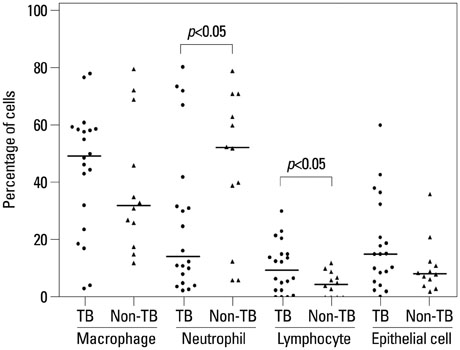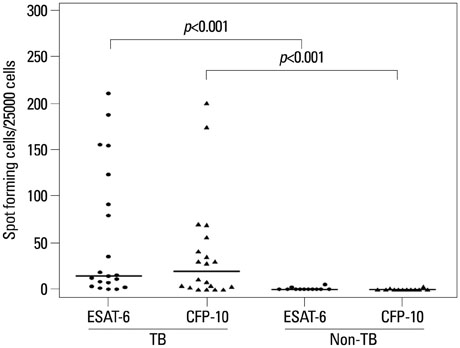Yonsei Med J.
2015 Mar;56(2):340-347. 10.3349/ymj.2015.56.2.340.
Potential Role of Immunodiagnosis for Pulmonary Tuberculosis Using Induced Sputum Cells
- Affiliations
-
- 1Department of Internal Medicine, Pusan National University School of Medicine, Yangsan, Korea.
- 2International Tuberculosis Research Center, Changwon, Korea. sooli10kr@yahoo.co.kr
- KMID: 2070008
- DOI: http://doi.org/10.3349/ymj.2015.56.2.340
Abstract
- PURPOSE
To evaluate the diagnostic utility and predictors for determinate results of an enzyme-linked immunospot assay using induced sputum cells (IS ELISPOT) for a rapid diagnosis of pulmonary tuberculosis (TB).
MATERIALS AND METHODS
Subjects suspected of pulmonary TB who had either sputum acid fast bacilli smear-negative or not producing sputum spontaneously were prospectively enrolled. ELISPOT assay was performed using cells from induced sputum.
RESULTS
A total of 43 subjects, including 25 with TB (TB group) and 18 with non-TB disease (non-TB group) were enrolled. Results of IS ELISPOT were determinate in only 17/43 (39%) subjects, but all of determinate results were consistent with the final diagnosis. Of the 43 sputum samples, 11 (26%) were inadequate to perform IS ELISPOT. Of 32 adequate sputum samples, the proportion of determinate results was significantly higher in the TB group (75%, 15/20) than in the non-TB group (17%, 2/12) (p=0.002). The status of active TB was a unique predictor but smear positivity was not a significant predictor for determinate results. In addition, sensitivity of IS ELISPOT (75%, 9/12) in smear negative TB was higher than that of TB-polymerase chain reaction (25%, 3/12).
CONCLUSION
IS ELISPOT showed relatively high diagnostic value and accuracy in the TB group, independent of smear positivity. IS ELISPOT may provide additional diagnostic yield for microbiological tools in the rapid diagnosis of smear-negative TB.
MeSH Terms
-
Adult
Aged
*Enzyme-Linked Immunospot Assay
Female
Humans
Immunologic Tests/*methods
Male
Middle Aged
Mycobacterium tuberculosis/*isolation & purification
Predictive Value of Tests
Prospective Studies
Reproducibility of Results
Risk Factors
Sensitivity and Specificity
Sputum/*microbiology
Tuberculosis, Pulmonary/*diagnosis/microbiology
Figure
Reference
-
1. Barnes PF, Lu S, Abrams JS, Wang E, Yamamura M, Modlin RL. Cytokine production at the site of disease in human tuberculosis. Infect Immun. 1993; 61:3482–3489.
Article2. Wilkinson KA, Wilkinson RJ, Pathan A, Ewer K, Prakash M, Klenerman P, et al. Ex vivo characterization of early secretory antigenic target 6-specific T cells at sites of active disease in pleural tuberculosis. Clin Infect Dis. 2005; 40:184–187.
Article3. Nemeth J, Winkler HM, Zwick RH, Rumetshofer R, Schenk P, Burghuber OC, et al. Recruitment of Mycobacterium tuberculosis specific CD4+ T cells to the site of infection for diagnosis of active tuberculosis. J Intern Med. 2009; 265:163–168.
Article4. Losi M, Bossink A, Codecasa L, Jafari C, Ernst M, Thijsen S, et al. Use of a T-cell interferon-gamma release assay for the diagnosis of tuberculous pleurisy. Eur Respir J. 2007; 30:1173–1179.
Article5. Thomas MM, Hinks TS, Raghuraman S, Ramalingam N, Ernst M, Nau R, et al. Rapid diagnosis of Mycobacterium tuberculosis meningitis by enumeration of cerebrospinal fluid antigen-specific T-cells. Int J Tuberc Lung Dis. 2008; 12:651–657.6. Kösters K, Nau R, Bossink A, Greiffendorf I, Jentsch M, Ernst M, et al. Rapid diagnosis of CNS tuberculosis by a T-cell interferon-gamma release assay on cerebrospinal fluid mononuclear cells. Infection. 2008; 36:597–600.
Article7. Cho OH, Park KH, Park SJ, Kim SM, Park SY, Moon SM, et al. Rapid diagnosis of tuberculous peritonitis by T cell-based assays on peripheral blood and peritoneal fluid mononuclear cells. J Infect. 2011; 62:462–471.
Article8. Jafari C, Ernst M, Kalsdorf B, Greinert U, Diel R, Kirsten D, et al. Rapid diagnosis of smear-negative tuberculosis by bronchoalveolar lavage enzyme-linked immunospot. Am J Respir Crit Care Med. 2006; 174:1048–1054.
Article9. Jafari C, Ernst M, Strassburg A, Greinert U, Kalsdorf B, Kirsten D, et al. Local immunodiagnosis of pulmonary tuberculosis by enzyme-linked immunospot. Eur Respir J. 2008; 31:261–265.
Article10. Jafari C, Thijsen S, Sotgiu G, Goletti D, Domínguez Benítez JA, Losi M, et al. Bronchoalveolar lavage enzyme-linked immunospot for a rapid diagnosis of tuberculosis: a Tuberculosis Network European Trialsgroup study. Am J Respir Crit Care Med. 2009; 180:666–673.
Article11. Dheda K, van Zyl-Smit RN, Meldau R, Meldau S, Symons G, Khalfey H, et al. Quantitative lung T cell responses aid the rapid diagnosis of pulmonary tuberculosis. Thorax. 2009; 64:847–853.
Article12. McWilliams T, Wells AU, Harrison AC, Lindstrom S, Cameron RJ, Foskin E. Induced sputum and bronchoscopy in the diagnosis of pulmonary tuberculosis. Thorax. 2002; 57:1010–1014.
Article13. Brown M, Varia H, Bassett P, Davidson RN, Wall R, Pasvol G. Prospective study of sputum induction, gastric washing, and bronchoalveolar lavage for the diagnosis of pulmonary tuberculosis in patients who are unable to expectorate. Clin Infect Dis. 2007; 44:1415–1420.
Article14. Breen RA, Hardy GA, Perrin FM, Lear S, Kinloch S, Smith CJ, et al. Rapid diagnosis of smear-negative tuberculosis using immunology and microbiology with induced sputum in HIV-infected and uninfected individuals. PLoS One. 2007; 2:e1335.
Article15. Cashmore TJ, Peter JG, van Zyl-Smit RN, Semple PL, Maredza A, Meldau R, et al. Feasibility and diagnostic utility of antigen-specific interferon-gamma responses for rapid immunodiagnosis of tuberculosis using induced sputum. PLoS One. 2010; 5:e10389.16. Dilektasli AG, Erdem E, Durukan E, Eyüboğlu FO. Feasibility of the T-SPOT.TB assay for the immunodiagnosis of smear-positive pulmonary tuberculosis using induced sputum. Int J Tuberc Lung Dis. 2010; 14:1205–1208.17. Chang KC, Leung CC, Yew WW, Tam CM. Supervised and induced sputum among patients with smear-negative pulmonary tuberculosis. Eur Respir J. 2008; 31:1085–1090.
Article18. Condos R, Rom WN, Liu YM, Schluger NW. Local immune responses correlate with presentation and outcome in tuberculosis. Am J Respir Crit Care Med. 1998; 157(3 Pt 1):729–735.
Article19. Jafari C, Ernst M, Kalsdorf B, Lange C. Comparison of molecular and immunological methods for the rapid diagnosis of smear-negative tuberculosis. Int J Tuberc Lung Dis. 2013; 17:1459–1465.
Article
- Full Text Links
- Actions
-
Cited
- CITED
-
- Close
- Share
- Similar articles
-
- Comparison of Induced Sputum and Bronchoscopy in Diagnosis of Active Pulmonary Tuberculosis
- Observation on sputum cytology in pulmonary tuberculosis
- Clinical evaluation of positive sputum AFB cases following pulmonary resection of pulmonary tuberculosis
- The Diagnostic Value of Bronchoalveolar lavage fluid microscopic study and PCR in Pulmonary tuberculosis
- Efficacy of Induced Sputum for the Diagnosis of Pulmonary Tuberculosis in Adults Unable to Expectorate Sputum



